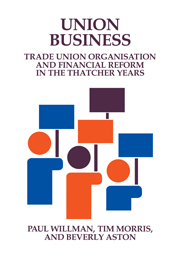Book contents
- Frontmatter
- Contents
- Acknowledgements
- 1 Introduction: unions in the 1980s
- 2 The financial status of British trade unions 1950–1989
- 3 Financial differences between unions
- 4 The role of financial matters in union organisation
- 5 The politics of union finaces
- 6 Union size, growth, and financial performance
- 7 Strike activity and union finances
- 8 The National Union of Mineworkers: strikes and financial disaster
- 9 The GMB: merger and financial reform
- 10 The Amalgamated Engineering Union: back from the brink
- 11 The Banking, Insurance and Finance Union: competitive unionism and financial survival
- 12 The Electrical, Electronic, Telecommunications and Plumbing Trade Union: accountability and financial control
- 13 Conclusions: union business and business unionism
- Appendix 1 Research methods
- Appendix 2 Regression results
- Appendix 3 Questions for finance officers
- Appendix 4 Questions for General Secretaries
- Appendix 5 Questionnaire: trade union finances
- Appendix 6 The number of trade unions
- Notes
- References
- Subject index
- Index of trade unions
- Author index
2 - The financial status of British trade unions 1950–1989
Published online by Cambridge University Press: 11 March 2010
- Frontmatter
- Contents
- Acknowledgements
- 1 Introduction: unions in the 1980s
- 2 The financial status of British trade unions 1950–1989
- 3 Financial differences between unions
- 4 The role of financial matters in union organisation
- 5 The politics of union finaces
- 6 Union size, growth, and financial performance
- 7 Strike activity and union finances
- 8 The National Union of Mineworkers: strikes and financial disaster
- 9 The GMB: merger and financial reform
- 10 The Amalgamated Engineering Union: back from the brink
- 11 The Banking, Insurance and Finance Union: competitive unionism and financial survival
- 12 The Electrical, Electronic, Telecommunications and Plumbing Trade Union: accountability and financial control
- 13 Conclusions: union business and business unionism
- Appendix 1 Research methods
- Appendix 2 Regression results
- Appendix 3 Questions for finance officers
- Appendix 4 Questions for General Secretaries
- Appendix 5 Questionnaire: trade union finances
- Appendix 6 The number of trade unions
- Notes
- References
- Subject index
- Index of trade unions
- Author index
Summary
Introduction
There have been three systematic studies of the financial status of British trade unions in the post-war period. All relied on the statutory returns described in Appendix 1. Roberts (1956: 343–95) analysed change across the period 1936–50, Latta (1972) looked at the decade 1960–70 and Willman and Morris (1988) looked at the period 1975–85. All three studies described the financial performance of particular unions as well as the financial status of unions as a whole. Their findings indicate that the financial fortunes of British trade unions have been highly variable over the last 40 years. In this chapter, we shall seek to present an up-to-date picture of the aggregate financial status for the post-war years and in the next a more detailed, disaggregated picture of events in the largest unions in the 1980s. We shall try to provide an explanation of aggregate changes and an account of the sources of variation in financial performance between unions.
The structure of the chapter is as follows. Section 2 discusses the findings of previous studies, and outlines the ratios used here. Section 3 presents the overall picture of union finances from 1950 to 1989. Section 4 discusses the implications of these trends. Section 5 concludes.
Previous studies of trade union finances
Although analysis of the financial status and arrangements of trade unions was central to the Webbs' classic study, particularly of the ‘new model’ unions (1907: 162–283), many more recent studies have not considered financial matters. The major exception is Roberts' (1956) study of trade union government and administration which systematically considered subscriptions, the management of union funds, expenditure, assets, and political funds.
- Type
- Chapter
- Information
- Union BusinessTrade Union Organisation and Financial Reform in the Thatcher Years, pp. 7 - 19Publisher: Cambridge University PressPrint publication year: 1993



